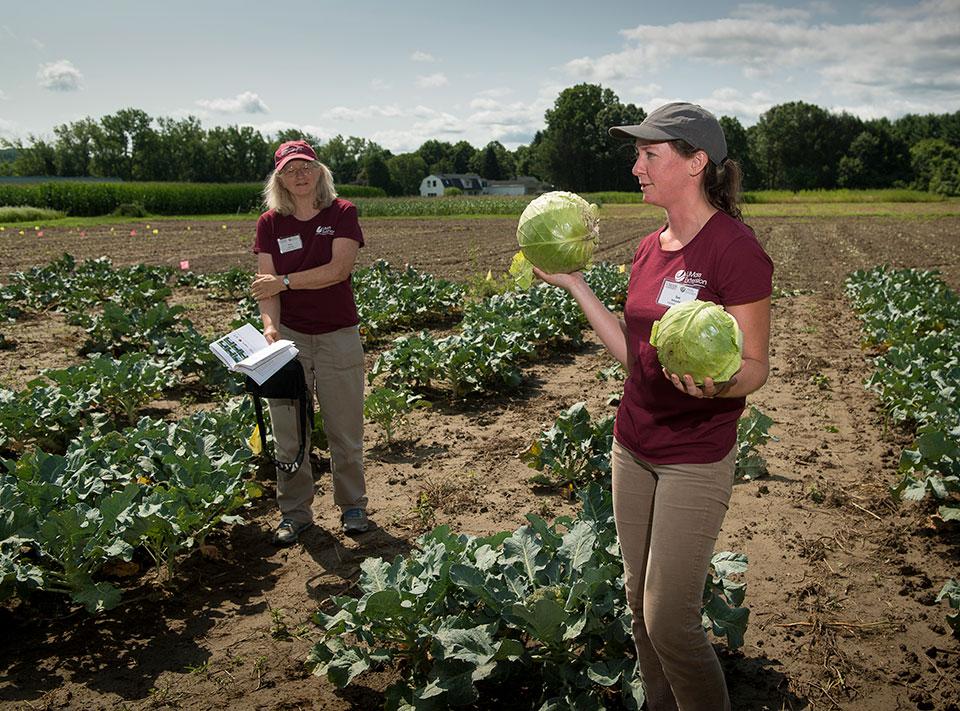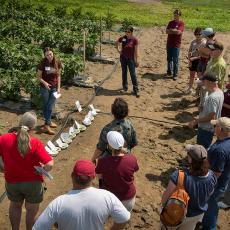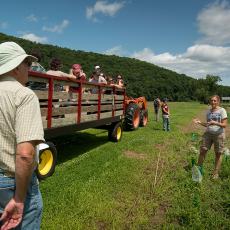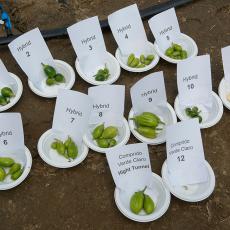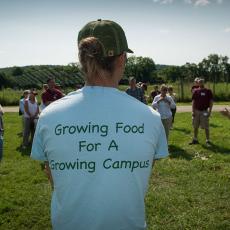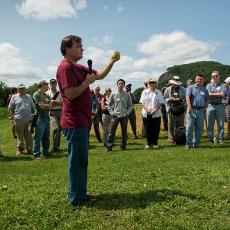Enjoy watching pigs run alongside foraging crops? Bumble bees being examined for disease-transmission effects from flowers? Examples of energy-efficient food storage? If so, you would have enjoyed UMass Agricultural Field Day on July 29th. Held under clear skies just twelve hours after an impressive thunderstorm, about 80 farmers, organizational representatives, researchers and others gathered in South Deerfield at the Crop and Animal Research Farm on North River Road from 10:00 to 4:00.
Organized by UMass Extension, the annual Field Day offered farmers and other interested people the opportunity to understand the latest innovations in crop research and the ability to interact directly with UMass Amherst researchers.
Attendees toured 18 trial sites around the farm to witness a wide variety of projects. Among them, an integrated pig and vegetable intercropping experiment. Frank Mangan, a vegetable researcher, is testing two side-by-side plots, one with ten pigs, winter rye and hairy vetch and the other with squash. He said, “We want to make the case that manure is an important part of our growing systems here in New England, many of which are small farms and we want to encourage this kind of rotation.” UMass is participating in the nationwide spring event, ‘Real Food Challenge’ where schools are asked to serve 30 percent of their meals with local, non-genetically-modified (GMO) foods. To that end, these pigs are fed with non-GMO crops.
Amanda Brown, Extension Educator with a specialty in vegetables and sustainable crops, along with Jarrod Fowler, USDA NRCS certified Technical Service Provider of Pollinator Habitat Enhancement Plans, offered up information on pollinator habitats. Plants on site to attract native pollinators include bee balm, yarrow, joe pye weed, catmint, lavender and sunflowers. They have observed honey bees, carpenter bees, sweat bees, bumble bees and mason bees at this garden. Nesting boxes were installed to assist native bees with safe habitat and evidence of use was noted. With four different weed control systems in place, their goal was to determine the best type of preparation for weed control when establishing native habitat adjacent to crops. Researchers installed a 50- gallon drum as a physical barrier called an “island,” islands with no physical barriers, black landscape cloth and woodchips. They determined that wood chips are the most efficient method of controlling weeds.
‘Bee Whisperer’ Lynn Adler, associate professor of biology, is examining floral traits affecting disease transmission in bumble bees. Goals of her team include examining the impact of plant chemical defenses on bee health and disease loads using bumble bees, honey bees and exploring their common diseases. Looking at pollen nectar and floral tissue in laboratory and field studies, she is taking a novel approach to provide insight into the diversity of roles that plant defensive chemical can play in food webs, while addressing the contemporary societal issue of bee health and disease.
Agronomy professor Stephen Herbert installed solar panels on farmland in a way that provides many benefits. His project effectively combines agriculture and solar energy as an innovative dual land use. His research showed that the farm is able maintain 90% pasture yield without shade for solar panels. Under these panels, cows are often found to graze contentedly. Positioning of solar panels is crucial to the success with 3.5 – 4.0 feet needed between panel clusters needed to maintain high pasture yield.
Research is also being conducted about biochar effects, integrated pest management, establishment of a carbon footprint and more.
